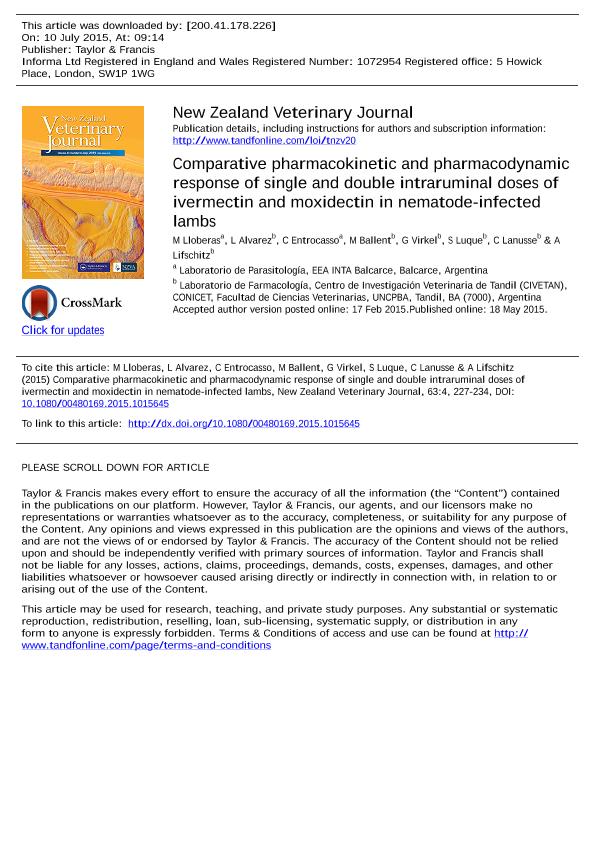Mostrar el registro sencillo del ítem
dc.contributor.author
Lloberas, Maria Mercedes

dc.contributor.author
Alvarez, Luis Ignacio

dc.contributor.author
Entrocasso, Carlos Miguel
dc.contributor.author
Ballent, Mariana

dc.contributor.author
Virkel, Guillermo Leon

dc.contributor.author
Luque, Sonia Elisabet

dc.contributor.author
Lanusse, Carlos Edmundo

dc.contributor.author
Lifschitz, Adrian Luis

dc.date.available
2020-06-30T15:13:24Z
dc.date.issued
2015-02
dc.identifier.citation
Lloberas, Maria Mercedes; Alvarez, Luis Ignacio; Entrocasso, Carlos Miguel; Ballent, Mariana; Virkel, Guillermo Leon; et al.; Comparative pharmacokinetic and pharmacodynamic response of single and double intraruminal doses of ivermectin and moxidectin in nematode-infected lambs; New Zealand Veterinary Association; New Zealand Veterinary Journal; 63; 4; 2-2015; 227-234
dc.identifier.issn
0048-0169
dc.identifier.uri
http://hdl.handle.net/11336/108504
dc.description.abstract
AIMS: To compare the pharmacokinetics, distribution and efficacy (pharmacodynamic response) of intraruminal ivermectin (IVM) and moxidectin (MXD) administered at 0.2 and 0.4 mg/kg to naturally nematode-infected lambs, and to determine the ex vivo accumulation of these anthelmintics by Haemonchus contortus. METHODS: Romney Marsh lambs, naturally infected with IVM-resistant H. contortus, were allocated to treatment groups based on faecal nematode egg counts. They received 0.2 or 0.4 mg/kg IVM or MXD (n=10 per group), or no treatment (Control; n=6), on Day 0. Samples from four animals from each treatment group, including abomasal parasites, were obtained on Day 1. Plasma samples were also collected from Day 0 to 14, and a faecal egg count reduction test (FECRT) and a controlled efficacy trial were carried out on Day 14. Concentrations of IVM and MXD in plasma, in abomasal and intestinal tissues and in H. contortus were evaluated by high-performance liquid chromatography. Additionally, the ex vivo drug accumulation of IVM and MXD by H. contortus was determined. RESULTS: Peak plasma concentrations and the area under the concentration vs. time curve for both IVM and MXD were higher for 0.4 than 0.2 mg/kg treatments (p<0.05), but there were no differences for other parameters. Concentrations of IVM and MXD in the gastrointestinal target tissues and in H. contortus were higher compared to those measured in plasma. Concentrations of both drugs in H. contortus were correlated with those observed in the abomasal content (r=0.86; p<0.0001). The exposure of H. contortus to IVM and MXD was related to the administered dose. Mean FECRT and efficacy for removal of adult H. contortus was 0% for IVM at 0.2 and 0.4 mg/kg. For MXD, FECRT were >95% for both treatments, and efficacy against H. contortus was 85.1% and 98.1% for 0.2 and 0.4 mg/kg, respectively. The ex vivo accumulation of IVM and MXD in H. contortus was directly related to the drug concentration present in the environment and was influenced by the duration of exposure. CONCLUSION: Administration of IVM and MXD at 0.4 compared with 0.2 mg/kg accounted for enhanced drug exposure in the target tissues, as well as higher drug concentrations within resistant nematodes. The current work is a further contribution to the evaluation of the relationship between drug efficacy and basic pharmacological issues in the presence of resistant parasite populations.
dc.format
application/pdf
dc.language.iso
eng
dc.publisher
New Zealand Veterinary Association

dc.rights
info:eu-repo/semantics/openAccess
dc.rights.uri
https://creativecommons.org/licenses/by-nc-sa/2.5/ar/
dc.subject
DRUG EXPOSURE
dc.subject
EFFICACY
dc.subject
EX VIVO ACCUMULATION
dc.subject
IVERMECTIN
dc.subject
MOXIDECTIN
dc.subject
PHARMACOKINETICS
dc.subject
RESISTANT HAEMONCHUS CONTORTUS
dc.subject.classification
Otras Ciencias Veterinarias

dc.subject.classification
Ciencias Veterinarias

dc.subject.classification
CIENCIAS AGRÍCOLAS

dc.title
Comparative pharmacokinetic and pharmacodynamic response of single and double intraruminal doses of ivermectin and moxidectin in nematode-infected lambs
dc.type
info:eu-repo/semantics/article
dc.type
info:ar-repo/semantics/artículo
dc.type
info:eu-repo/semantics/publishedVersion
dc.date.updated
2020-06-23T15:47:04Z
dc.identifier.eissn
1176-0710
dc.journal.volume
63
dc.journal.number
4
dc.journal.pagination
227-234
dc.journal.pais
Nueva Zelanda

dc.journal.ciudad
Wellington
dc.description.fil
Fil: Lloberas, Maria Mercedes. Instituto Nacional de Tecnología Agropecuaria. Centro Regional Buenos Aires Sur. Estación Experimental Agropecuaria Balcarce. Agencia de Extensión Rural Balcarce; Argentina
dc.description.fil
Fil: Alvarez, Luis Ignacio. Consejo Nacional de Investigaciones Científicas y Técnicas. Centro Científico Tecnológico Conicet - Tandil. Centro de Investigación Veterinaria de Tandil. Universidad Nacional del Centro de la Provincia de Buenos Aires. Centro de Investigación Veterinaria de Tandil. Provincia de Buenos Aires. Gobernación. Comision de Investigaciones Científicas. Centro de Investigación Veterinaria de Tandil; Argentina
dc.description.fil
Fil: Entrocasso, Carlos Miguel. Instituto Nacional de Tecnología Agropecuaria. Centro Regional Buenos Aires Sur. Estación Experimental Agropecuaria Balcarce. Agencia de Extensión Rural Balcarce; Argentina
dc.description.fil
Fil: Ballent, Mariana. Consejo Nacional de Investigaciones Científicas y Técnicas. Centro Científico Tecnológico Conicet - Tandil. Centro de Investigación Veterinaria de Tandil. Universidad Nacional del Centro de la Provincia de Buenos Aires. Centro de Investigación Veterinaria de Tandil. Provincia de Buenos Aires. Gobernación. Comision de Investigaciones Científicas. Centro de Investigación Veterinaria de Tandil; Argentina
dc.description.fil
Fil: Virkel, Guillermo Leon. Consejo Nacional de Investigaciones Científicas y Técnicas. Centro Científico Tecnológico Conicet - Tandil. Centro de Investigación Veterinaria de Tandil. Universidad Nacional del Centro de la Provincia de Buenos Aires. Centro de Investigación Veterinaria de Tandil. Provincia de Buenos Aires. Gobernación. Comision de Investigaciones Científicas. Centro de Investigación Veterinaria de Tandil; Argentina
dc.description.fil
Fil: Luque, Sonia Elisabet. Consejo Nacional de Investigaciones Científicas y Técnicas. Centro Científico Tecnológico Conicet - Tandil. Centro de Investigación Veterinaria de Tandil. Universidad Nacional del Centro de la Provincia de Buenos Aires. Centro de Investigación Veterinaria de Tandil. Provincia de Buenos Aires. Gobernación. Comision de Investigaciones Científicas. Centro de Investigación Veterinaria de Tandil; Argentina
dc.description.fil
Fil: Lanusse, Carlos Edmundo. Consejo Nacional de Investigaciones Científicas y Técnicas. Centro Científico Tecnológico Conicet - Tandil. Centro de Investigación Veterinaria de Tandil. Universidad Nacional del Centro de la Provincia de Buenos Aires. Centro de Investigación Veterinaria de Tandil. Provincia de Buenos Aires. Gobernación. Comision de Investigaciones Científicas. Centro de Investigación Veterinaria de Tandil; Argentina
dc.description.fil
Fil: Lifschitz, Adrian Luis. Consejo Nacional de Investigaciones Científicas y Técnicas. Centro Científico Tecnológico Conicet - Tandil. Centro de Investigación Veterinaria de Tandil. Universidad Nacional del Centro de la Provincia de Buenos Aires. Centro de Investigación Veterinaria de Tandil. Provincia de Buenos Aires. Gobernación. Comision de Investigaciones Científicas. Centro de Investigación Veterinaria de Tandil; Argentina
dc.journal.title
New Zealand Veterinary Journal

dc.relation.alternativeid
info:eu-repo/semantics/altIdentifier/url/https://www.tandfonline.com/doi/abs/10.1080/00480169.2015.1015645
dc.relation.alternativeid
info:eu-repo/semantics/altIdentifier/doi/http://dx.doi.org/10.1080/00480169.2015.1015645
Archivos asociados
